
1.
Pure and Natural Insect Repellant - From the kitchen of
Barbara Kavanagh
This spray is so pure and good for you that you can spray it freely
all over your skin, including your face. You can even safely inhale
it.
![]()

| In an 8 ounce spray bottle mix: 1/2 tsp. peppermint 1 tsp. cedarwood 1 tsp. eucalyptus 2 tsp. citronella 1 1/2 tsp. lemongrass |
In a 24 ounce spray bottle mix: 1 tsp. peppermint 2 tsp. cedarwood 2 tsp. eucalyptus 3 tsp. citronella 3 tsp. lemongrass |

Filling the remainder of the bottle with Witch Hazel. SHAKE
WELL before each use and apply often.
Essential oils can be bought at health food stores. Be sure the bottle says "pure" essential oil, otherwise you are wasting your money and will not get the desired results. Treats in San Andreas, California has the best price in town for Witch Hazel.
2.
Keeping Your Fish Moist
To keep your fish catch from drying out while transporting it
to your cooking site, wrap the fish in grass and dip the bound
bundle in creek water to moisten the fish. Field dress your fish
first, if you will be traveling for a long distance. The cordage
for tying the bundle was made from braided grass.
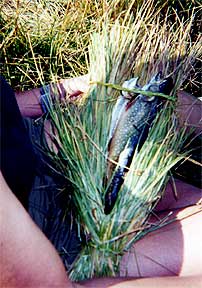
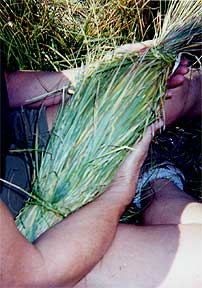
3.
Gathering Fire-by-Friction Wood
When looking for a spindle or a hearthboard to use for the fire-by-friction
method, gather dead wood off of the appropriate plant. The dead
wood found on the plant should be completely dry and have some
firmness to the structure. Disregard dead wood that is too crumbly
or breaks very easily in your hands. Do not use wood that has
been lying on the ground for a long time. Decomposing or punky
wood do not make suitable spindle or hearthboard materials. Some
large, downed dead wood that still has a firm core can still be
utilized for a hearthboard. Check to see if the center is still
solid and not rotted or soft.
If you are going to use the material immediately, do not gather green wood directly from the plant. Green wood can still be utilized, but only if you thoroughly dry out the moist material or the sap in the cells of the wood. Drying time depends upon the size of the wood, its age when cut (older trees have less sap), season of cutting, and climate. If you have the time, it's best to prepare your spindle and hearthboard by drying out green material.
4. Coyote Brush (Baccharis pilularis)
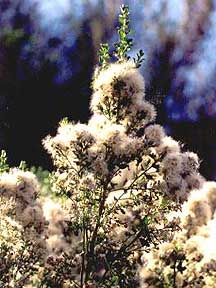
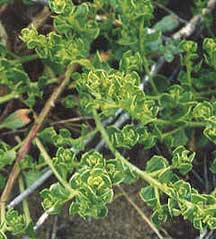
Coyote brush or coyote bush is a common shrub around riparian
or creek areas in California. It tends to have a rounded shape
and grows up to 8 feet tall. It is covered with small, toothed
leaves that remain green year round.
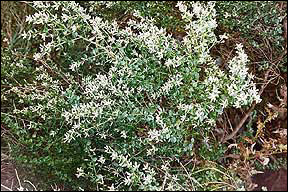 The coyote brush
is used today as a salve for an itchy mosquito bite or
the effects of Stringing Nettle. First, chew up several leaves
(note: never put any plant in your mouth unless a trained professional
has identified it for you and said it is all right to do so).
Next, spit the chewed leaves into your hand, form a green poultice
and place it on the irritation. The itching is quickly relieved
as the astringent properties of the plant dry out the bite or
stinging effects.
The coyote brush
is used today as a salve for an itchy mosquito bite or
the effects of Stringing Nettle. First, chew up several leaves
(note: never put any plant in your mouth unless a trained professional
has identified it for you and said it is all right to do so).
Next, spit the chewed leaves into your hand, form a green poultice
and place it on the irritation. The itching is quickly relieved
as the astringent properties of the plant dry out the bite or
stinging effects.
A leaf poultice for insect bites and cuts was also made from Broadleaf plantain and Narrowleaf plantain.
5.
Paul Krebaum, a chemist at Molex Inc. added a dash of soap
to hydrogen peroxide and baking soda, and  developed
the first home remedy for skunk spray.
developed
the first home remedy for skunk spray.
How do you get rid of the smell that comes from two tiny but
ingenious glands at the business end of a skunk? A garden hose
is impotent, soap is utterly useless, and tomato juice is a quaint
old wives' tale that has left many people with skunk-sprayed dogs
that not only stink, but are pink.
Krebaum came up with a formula that neutralized the foul smelling
thiols in skunk spray. His formula was 1 quart of 3 percent hydrogen
peroxide, which costs about $2 at a drugstore, 1/4 cup of baking
soda, and 1 teaspoon of liquid soap, which breaks up the oils
in skunk spray and allows the other ingredients in the solution
to do their stuff. The solution, after applying, should be rinsed
off your pet with tap water. It works!
6.
Carving with Green Wood.
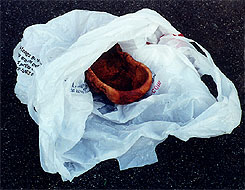 Keeping a carving
of green wood covered in plastic between carving sessions will
prevent rapid drying and changes in stress. Splitting as the result
of drying always starts from the outside of a log as the
Keeping a carving
of green wood covered in plastic between carving sessions will
prevent rapid drying and changes in stress. Splitting as the result
of drying always starts from the outside of a log as the  sapwood shrinks more than the heartwood.
If you cannot work on your roughed out wood for a long period
of time, submerge the carving in a bucket of water and add some
bleach. The outer surface color will darken over time, but it
can be removed with additional carving and sanding. The wood will
still have it's natural color under the surface. It will be odor
free and with no cracks. When you're finished with your carving,
apply a coating of Saffola (pure safflower oil) or mineral oil.
sapwood shrinks more than the heartwood.
If you cannot work on your roughed out wood for a long period
of time, submerge the carving in a bucket of water and add some
bleach. The outer surface color will darken over time, but it
can be removed with additional carving and sanding. The wood will
still have it's natural color under the surface. It will be odor
free and with no cracks. When you're finished with your carving,
apply a coating of Saffola (pure safflower oil) or mineral oil.
If you have the time, it's best to seal the ends of the log and
let it dry naturally until the wood has stabilized. This may take
months to a year, depending on the type of wood and the climate.
7.
Aging clay
The 12th and 13th century Japanese potters used a clay mixture
of equal amounts of clay and volcanic ash. To age the clay, they
placed a bit of yam peels wrapped in rags and added it to the
mixture to assist in the aging process. It started bacterial growth
that melted the ash and clay. The clay was aged for several months
before use.
8. Fire Starting Tinder
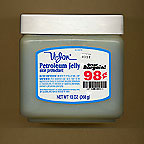
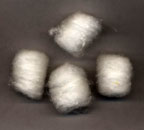

Create your own fire starting tinder with petroleum jelly, cotton balls (100% cotton), and an empty film canister. Saturate the individual cotton balls in petroleum jelly. Then store the cotton balls in the film canister. That's all there is to it. Whenever you need a reliable tinder to ignite your campfire, take out one of the cotton balls, fuzz up the edge by pulling on the loose cotton fibers, and light it with a match. The cotton ball will burn for a long time, enabling your twigs and logs to catch on fire.
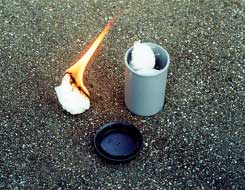
9.
Western North Carolina Fire Starting Tips
During the wetter months in the mountains of Western North
Carolina, dry wood for fire starting can be difficult to acquire.
The best method I've found is to look for the hemlock trees. The
thick foliage acts as a natural umbrella. An umbrella so efficient
that the lower few branches tend to die out from lack of light.
You can usually find them still attached to the tree, bone dry,
everything from 2 inch thick branches to thin little twigs. Also,
at the higher altitudes, mountain laurel makes a great fuel for
cooking. The best are the pieces that have died and snagged above
the ground so that they're bone dry. It burns fast, but it puts
out a lot of heat and a lot of light.
Submitted by kagemusha8@aol.com
E-mail your comments to "Dino Labiste" at KahikoArts@yahoo.com
We hope the information on the PrimitiveWays website is both instructional and enjoyable. Understand that no warranty or guarantee is included. We expect adults to act responsibly and children to be supervised by a responsible adult. If you use the information on this site to create your own projects or if you try techniques described on PrimitiveWays, behave in accordance with applicable laws, and think about the sustainability of natural resources. Using tools or techniques described on PrimitiveWays can be dangerous with exposure to heavy, sharp or pointed objects, fire, stone tools and hazards present in outdoor settings. Without proper care and caution, or if done incorrectly, there is a risk of property damage, personal injury or even death. So, be advised: Anyone using any information provided on the PrimitiveWays website assumes responsibility for using proper care and caution to protect property, the life, health and safety of himself or herself and all others. He or she expressly assumes all risk of harm or damage to all persons or property proximately caused by the use of this information.
© PrimitiveWays 2013